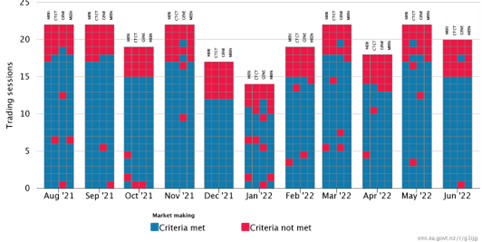Eye on electricity
Exchange traded electricity futures margins update
- Distribution
- Retail
- Wholesale
In June 2022, the Australian Securities Exchange (ASX) released the latest margin requirements for exchange traded New Zealand electricity futures. This latest update remains consistent with the changes to margin requirements adopted in September 2021.
In September 2021 margin percentages changed with the majority of ASX New Zealand electricity base load and peak futures experiencing increases. For some products such as near-term Otahuhu Base Quarter Futures, the initial margin for New Zealand base load electricity futures can be at 45% of the total contract value. This has primarily been a reflection of higher energy prices and greater volatility in the global energy markets.
Whenever a futures contract is traded, an end-user will be required to post an initial margin with their Clearing Participant, who pay margins to ASX Clear (Futures) (the clearing house). A margin is held by the clearing house to cover the risk to the exchange if a Clearing Participant were to default. As well as initial margins, additional margin may be required to cover for changes in the market value of the contract, these additional margins are known as variation margin.
New Zealand electricity futures can be traded on the ASX platform with margins calculated by ASX Clear (Futures) and collected from each Clearing Participant. To access the ASX platform, end-users may need to use a Trading Participant, who has access to a Clearing Participant. A Clearing Participant may impose different margin requirements to ASX Clear (Futures).
The Authority recently made changes to market-making services that will go live on 1 September 2022 and will improve the ability for end-users to operate in the futures market. The Authority anticipates that these changes will result in fewer periods where all market makers are absent from the futures market. This will reduce price uncertainty because there will be more trading days with market makers and improved liquidity in the form of volume depth in the futures market. The greater liquidity at the end of a calendar month will provide end-users with more volume to trade into and will likely assist them in the management of their futures inventory.

The Authority acknowledges a robust futures market is critical for end-users in the New Zealand electricity market. The futures market plays an important role towards the Authority’s statutory objective (competition, reliability, and efficiency) for the long-term benefit of consumers.
Related News
Contract extension for commercial market making services
The Electricity Authority Te Mana Hiko has extended by eight months the end of the current contract to provide commercial market making services.
Information session for retailers on new mandatory reporting under the Retail Market Monitoring notice
We invite retailers to our information session where we will answer your questions ahead of the first report which is due on 31 August 2025.
Consultation open on distribution system operation models
We are consulting on three alternative models for distribution system operation as part of the Future System Operations project.